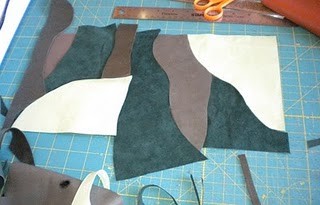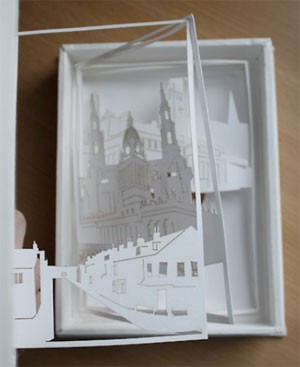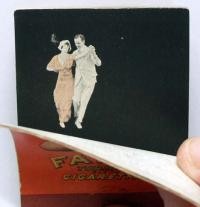 Bookbinder Rhonda Miller has a nice post on her blog about the “patchwork-covered” books she’s made using the large pile of leather scraps she’s amassed. Must have been fun to figure out how to arrange all the odd shapes and mix & match the colors…
Bookbinder Rhonda Miller has a nice post on her blog about the “patchwork-covered” books she’s made using the large pile of leather scraps she’s amassed. Must have been fun to figure out how to arrange all the odd shapes and mix & match the colors…
 Bookbinder Rhonda Miller has a nice post on her blog about the “patchwork-covered” books she’s made using the large pile of leather scraps she’s amassed. Must have been fun to figure out how to arrange all the odd shapes and mix & match the colors…
Bookbinder Rhonda Miller has a nice post on her blog about the “patchwork-covered” books she’s made using the large pile of leather scraps she’s amassed. Must have been fun to figure out how to arrange all the odd shapes and mix & match the colors…
 First, look at the pictures of the finished book here, then read how she made the book, including creating the design using Illustrator then using a laser cutter to do the cutouts. While there’s wonderful detail in this post, I especially appreciated that she decided to put a hole into both the back and front covers to entice viewers to open the book… There’s more on her blog about making books and other artful things. (Unfortunately I can’t find the name of the artist anywhere on her blog!?)
First, look at the pictures of the finished book here, then read how she made the book, including creating the design using Illustrator then using a laser cutter to do the cutouts. While there’s wonderful detail in this post, I especially appreciated that she decided to put a hole into both the back and front covers to entice viewers to open the book… There’s more on her blog about making books and other artful things. (Unfortunately I can’t find the name of the artist anywhere on her blog!?)
UPDATE: Since I wrote this, the artist added her name and contact info to her blog. It’s Hannah Prentice. (Thanks Celia, for noticing this!)
 The Princeton Library blog has a nice post on the kineographs (flipbooks) in their collection. About the book to the left, they say “The Liggett & Myers Tobacco Company (better known as L&M) produced a brand of Turkish cigarettes under the name Fatima… In 1914, L&M released ten flipbooks under the theme of modern dance. ‘These moving picture booklets on the Dances of to-day … make it possible for all to know what the latest accepted dances are and how to dance them.'”
The Princeton Library blog has a nice post on the kineographs (flipbooks) in their collection. About the book to the left, they say “The Liggett & Myers Tobacco Company (better known as L&M) produced a brand of Turkish cigarettes under the name Fatima… In 1914, L&M released ten flipbooks under the theme of modern dance. ‘These moving picture booklets on the Dances of to-day … make it possible for all to know what the latest accepted dances are and how to dance them.'”
![]() See more pictures of this and their other flipbooks here. They also have a link to the large collection at flipbook.info.
See more pictures of this and their other flipbooks here. They also have a link to the large collection at flipbook.info.
This week I read Olive Kitteridge by Elizabeth Strout. It’s a set of linked short stories, with the character of Olive Kitteridge, an older woman living in Maine, appearing, sometimes peripherally, in all of them. From the first chapter, I was struck by the stories the characters told themselves, about how they developed into their present selves and why. It was, for me, a sad book — Olive isn’t particularly nice or likable and the plots are usually about some sort of betrayal. But the writing is excellent and made me want to read on.
![]() As I’ve thought vaguely about storytelling throughout the week, I was taken with Radha Pandey’s post on the Bookbinding Etsy Street Team about the Katha-Peti (or story chest) from India. It’s a large and colorful artist’s book! Here are a few pictures below, but do look here to see many more, and a fuller explanation.
As I’ve thought vaguely about storytelling throughout the week, I was taken with Radha Pandey’s post on the Bookbinding Etsy Street Team about the Katha-Peti (or story chest) from India. It’s a large and colorful artist’s book! Here are a few pictures below, but do look here to see many more, and a fuller explanation.
I’ve written about flexagons before — if you aren’t familiar with flexagons, they are flat “books” made from folded paper that are then unfolded, or flexed, to reveal a number of hidden faces. From my post, you can download a PDF on how to make them. They can be tricky to construct and tricky for the recipient to unfold-refold them.
![]() I ran across another similar structure, the infinity card which also folds and refolds but is far easier to design and construct. The video below shows how to make them. You can download Marilyn Scott Waters’ design to make your own at the bottom of this page. Waters also has a website with lots of free downloads of paper toys you can make.
I ran across another similar structure, the infinity card which also folds and refolds but is far easier to design and construct. The video below shows how to make them. You can download Marilyn Scott Waters’ design to make your own at the bottom of this page. Waters also has a website with lots of free downloads of paper toys you can make.
[youtube IzfLhSo2nQQ]
 At lunch today, as I idly paged through the Sunday paper, I recognized the images above. They brought back a flood of memories about the year long artists book class I took in 2001 at the San Francisco Center for the Book. As part of the course, we read excerpts from Johanna Drucker’s The Century Of Artists’ Books. These excerpts were supremely frustrating because there weren’t any pictures, just prose descriptions. After one class where we discussed books as a linear sequence, I somehow found all the pictures from a book by Ida Applebroog that was mentioned and made my own copy. Her drawings were primitive, and it gave me inspiration (or permission?) to use my own rather crude images in my own books.
At lunch today, as I idly paged through the Sunday paper, I recognized the images above. They brought back a flood of memories about the year long artists book class I took in 2001 at the San Francisco Center for the Book. As part of the course, we read excerpts from Johanna Drucker’s The Century Of Artists’ Books. These excerpts were supremely frustrating because there weren’t any pictures, just prose descriptions. After one class where we discussed books as a linear sequence, I somehow found all the pictures from a book by Ida Applebroog that was mentioned and made my own copy. Her drawings were primitive, and it gave me inspiration (or permission?) to use my own rather crude images in my own books.
![]() The article about Applebroog is interesting. But even more so is this PBS documentary, part of the art:21 series. She starts off talking about making books at the beginning of her career, and also shows her techniques and working methods for her other artwork. (If you watch the documentary, there’s another artist featured first, so click on the 4th icon in the control bar at the bottom of the video, to start at “Chapter 4 of 16.”)
The article about Applebroog is interesting. But even more so is this PBS documentary, part of the art:21 series. She starts off talking about making books at the beginning of her career, and also shows her techniques and working methods for her other artwork. (If you watch the documentary, there’s another artist featured first, so click on the 4th icon in the control bar at the bottom of the video, to start at “Chapter 4 of 16.”)